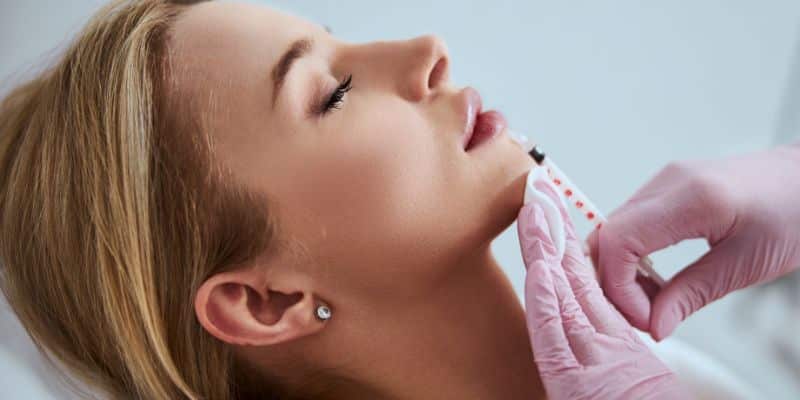
The rising demand for non-surgical lip enhancement treatments, fuelled by a societal emphasis on aesthetics, has led to the proliferation of various dermal fillers. Among these, Radiesse and Juvederm stand out as popular choices in the realm of cosmetic dermatology. This article seeks to compare these two fillers, offering a detailed evaluation of their composition, efficacy, potential side effects, and best practices for usage in lip augmentation procedures.
With this comparison, the article aims to assist medical professionals in making informed decisions when selecting dermal fillers for their patients, by illuminating the unique properties and potential outcomes of Radiesse and Juvederm. Moreover, it offers a review of current clinical studies and anecdotal observations from the field, thereby fostering an understanding grounded in both empirical data and practical experience. Let’s get started by looking at these two dermal filler brands.
Overview of Radiesse
Radiesse is a well-recognized injectable dermal filler that has been widely used in the aesthetic industry for its biostimulatory properties. It’s chiefly composed of Calcium Hydroxylapatite (CaHA) microspheres suspended in an aqueous gel carrier.
Calcium Hydroxylapatite is a naturally occurring substance in the human body, found predominantly in bones and teeth. In Radiesse, the CaHA microspheres are synthetic, bio-degradable, and non-immunogenic, ensuring its safety when administered correctly. Each microsphere measures between 25 to 45 micrometers, an ideal size for its function in tissue augmentation.
Radiesse has a remarkable history. Initially, it was developed for vocal cord augmentation and urinary incontinence treatment. Over time, its range of clinical applications expanded, and in 2006, it received FDA approval for nasolabial fold correction, with further approvals following for facial lipoatrophy treatment in HIV patients, and hand rejuvenation.
Though it does not have specific FDA approval for lip augmentation, Radiesse is used off-label for this purpose, due to its unique properties that promote collagenesis. When injected, Radiesse provides immediate volume correction. Its CaHA microspheres serve as a scaffold for new collagen production, leading to a longer-lasting result than some other dermal fillers. Over time, as the gel carrier is metabolically degraded, the new collagen matrix persists, maintaining the volume enhancement.
In terms of longevity, Radiesse outcomes can last up to 12-18 months, depending on the treatment area and individual patient characteristics. It’s essential, however, to note that the longevity of effect also relies on the injector’s skill and understanding of the product’s ideal placement.
One of the distinguishing characteristics of Radiesse is its non-reversibility, unlike hyaluronic acid-based fillers. If undesired effects occur, they can’t be readily dissolved; instead, one must wait for the natural metabolism of the product. Therefore, an in-depth understanding of facial anatomy and injection techniques is paramount to avoid complications and maximize patient satisfaction.
Furthermore, Radiesse is contraindicated for certain patient populations, including those with severe allergies, bleeding disorders, or hypersensitivity to any of the components of Radiesse.
Overview of Juvederm
Juvederm represents one of the most widely recognized names in the world of non-surgical facial rejuvenation. As an injectable dermal filler, it has been lauded for its versatility and effectiveness in a variety of aesthetic applications, one of which is lip augmentation.
At its core, Juvederm is a hyaluronic acid (HA)-based filler. Hyaluronic acid is a naturally occurring substance in the human body, particularly abundant in the skin, connective tissues, and eyes. This molecule has an innate ability to bind and retain water, contributing to the hydration, volume, and elasticity of the skin. By using this as its primary component, Juvederm provides a biocompatible and relatively low-risk option for individuals seeking subtle to moderate aesthetic improvements.
Juvederm was developed and is marketed by Allergan, a global pharmaceutical company. Since its introduction in 2006, it has emerged as a preferred choice for numerous clinicians owing to its ease of use, predictable results, and good safety profile.
Juvederm comprises a family of products, each tailored for specific applications. For instance, Juvederm Ultra XC and Juvederm Volbella XC are commonly used for lip enhancement. These products differ in their HA concentration and cross-linking technology, leading to variance in their longevity, cohesivity, and tissue integration, thus allowing clinicians to choose a product based on the patient’s specific needs and desired outcomes.
The FDA has granted approval to Juvederm for various indications, including the correction of moderate to severe facial wrinkles and folds, such as nasolabial folds. Certain products within the Juvederm range, including Juvederm Ultra XC and Juvederm Volbella XC, have specific approval for lip augmentation in adults over the age of 21.
Beyond lip augmentation, Juvederm has also found utility in other aesthetic applications, including the enhancement of facial volume in areas such as the cheeks (via Juvederm Voluma XC) and the smoothing of perioral lines.
Despite the popularity of Juvederm, it is important for clinicians to be aware of potential adverse reactions. While generally considered safe, possible side effects can include injection site redness, pain, firmness, swelling, lumps/bumps, bruising, itching, and discoloration. Most of these are mild in nature and resolve on their own within two weeks.
In summary, Juvederm’s composition, history, range, and FDA approval status, along with its common applications, make it a widely accepted and multifaceted tool in the field of aesthetic medicine. As with any medical intervention, the careful consideration of patient needs, expected outcomes, and potential side effects is paramount to ensure the best patient care.

Comparing Radiesse and Juvederm for Lip Augmentation
Radiesse and Juvederm both stand as leading choices in the realm of non-surgical lip augmentation. Despite sharing this common ground, they are fundamentally different in their composition, which consequently impacts their longevity, reversibility, potential side effects, and clinical outcomes.
Radiesse consists of calcium hydroxylapatite (CaHA) microspheres suspended in an aqueous gel carrier. The CaHA acts as a volumizer, filling in wrinkles and folds, while the gel carrier provides immediate volume correction and stimulates the production of the patient’s own collagen. However, Radiesse is not often employed for lip augmentation due to its semi-permanent nature and inability to dissolve, unlike hyaluronic acid fillers. Furthermore, the use of Radiesse in the lips can lead to nodule formation and may have a higher risk of complications compared to hyaluronic acid fillers.
Juvederm, on the other hand, is a family of injectable hyaluronic acid dermal fillers used to provide up to one year of correction for moderate to severe facial wrinkles and folds, such as nasolabial folds. Hyaluronic acid is a naturally occurring substance in the body that provides volume and fullness to the skin. In the case of lip augmentation, it offers smooth and natural results with less risk of nodules or granulomas. It’s crucial to note that hyaluronic acid fillers are reversible through the administration of hyaluronidase, allowing practitioners to correct or adjust the results post-treatment.
Recent studies show a high degree of patient satisfaction with both products. However, the procedural success heavily relies on the practitioner’s skill and the individual patient’s reaction to the filler. It is therefore necessary to tailor treatment plans according to each patient’s unique needs and expected outcomes. Both Radiesse and Juvederm can offer patients an improved aesthetic appearance, albeit with unique considerations that can significantly influence the choice of filler.
Comparing potential side effects, Radiesse may cause inflammatory nodules, discoloration, and induration due to its semi-permanent nature. Conversely, Juvederm can lead to transient issues such as swelling, tenderness, bruising, firmness, lumps/bumps, discoloration, and itching, predominantly due to its high hygroscopic nature.
In summary, the selection between Radiesse and Juvederm for lip augmentation hinges upon a variety of factors, including the individual patient’s needs, expected longevity of results, potential for reversibility, risk profile, and the treating doctor’s experience and comfort level with each product. As always, the ultimate goal is to ensure patient safety while achieving desired aesthetic outcomes.
Best Practices for Lip Augmentation
Lip augmentation using dermal fillers such as Radiesse or Juvederm necessitates precise planning, meticulous technique, and conscientious post-procedure follow-up. When utilized correctly, these substances can create harmonious, natural-looking outcomes.
Patient consultation serves as a crucial first step. An open dialogue about the patient’s aesthetic goals is essential. Understanding their expectations, ensuring that these are realistic, and informing them of potential risks and benefits associated with each treatment type is vital. Thorough facial assessment, including lip anatomy, symmetry, and proportion to other facial features, aids in determining the best treatment approach. The use of pre-procedure photographs can be invaluable for both patient communication and for later review.
The procedure itself demands a detailed understanding of lip anatomy and careful technique. It is recommended to use aseptic techniques, including skin disinfection, to minimize the risk of infection. The depth of injection can affect both the results and the risk of complications, and as such, it is vital to adjust this depending on the chosen filler and the specific area of the lips being treated. For example, injections into the body of the lip should typically be deeper, while vermillion border enhancements may require more superficial placement.
The volume of filler to be injected should be judiciously determined, with the principle of “less is more” often leading to the most aesthetically pleasing results. Overcorrection should generally be avoided, especially in first-time patients, and incremental treatments are preferable for achieving a gradual, natural enhancement.
Post-procedure care instructions should be communicated clearly to patients. They should be advised to avoid extreme facial expressions, strenuous exercise, and exposure to intense heat or cold for the first 24-48 hours. Regular follow-ups are advised to monitor the results and deal with any potential complications promptly.
Managing potential complications is another crucial aspect of best practice. Complications such as vascular occlusion, although rare, require immediate attention. Clinicians should be prepared to manage these emergencies, including having protocols in place for the use of hyaluronidase, if Juvederm or another hyaluronic acid-based filler has been used.
Conclusions
The choice between Radiesse and Juvederm for lip augmentation depends on a nuanced consideration of the desired outcome, the patient’s specific circumstances, and the potential side effects. Both fillers have proven effectiveness in lip augmentation, but each exhibits unique characteristics that may lend to specific clinical scenarios.
Radiesse, composed of Calcium Hydroxylapatite, may provide more structural augmentation, which can be beneficial for patients seeking a more pronounced enhancement. However, its lack of reversibility may pose a limitation for some patients. Juvederm, on the other hand, made of Hyaluronic Acid, offers a temporary, reversible solution that allows for adjustments or complete dissolution if necessary.
It’s essential to note that patient selection, thorough consultation, and proper injection techniques are key factors in achieving successful outcomes. Both Radiesse and Juvederm can deliver satisfactory results if used judiciously and skillfully.
In conclusion, the decision between Radiesse and Juvederm should be based on an individualized assessment of the patient’s goals and needs, combined with an understanding of the inherent properties of each filler. This knowledge will allow for optimal patient care and enhance aesthetic outcomes in lip augmentation.

About the Author: Doris Dickson is a specialist writer for Health Supplies Plus, focusing on the aesthetic medicine industry. She diligently researches cosmetic treatments and products to provide clear, concise information relevant to licensed medical professionals. Her work supports Health Supplies Plus’s commitment to being a reliable informational resource and trusted supplier for the aesthetic community.
Disclaimer: The content provided in this article is intended for informational purposes only and is directed towards licensed medical professionals. It is not intended to be a substitute for professional medical advice, diagnosis, or treatment, nor does it constitute an endorsement of any specific product or technique. Practitioners must rely on their own professional judgment, clinical experience, and knowledge of patient needs, and should always consult the full product prescribing information and relevant clinical guidelines before use. Health Supplies Plus does not provide medical advice.
